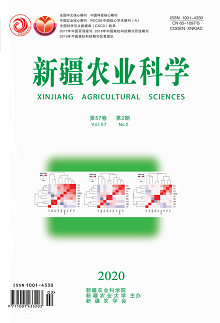|
|
Comparative Study on Production Performance of 10 Oat Varieties
WANG Yanchao, SONG Lei, ZHANG Fanfan, WANG Xuzhe, SUN Yanmei, MA Chunhui
2020, 57(2):
254-263.
DOI: 10.6048/j.issn.1001-4330.2020.02.006
【Objective】 By observing the agronomic traits, production performance and nutritional quality of 10 oat varieties at different growth stages, the varieties suitable for local cultivation were selected. 【Method】 The following varieties were selected for experiments: Qingyin 1, Denmark 440, Monida, Jiayan 2, Bayan 3, Charisma, Forage plus, Lena, Baler 2, Everleaf. They were sown on April 28, 2018, and the agronomic traits at heading stage, milking stage and maturity stage were observed, and the nutritional indexes of each variety were measured at the same time. 【Result】 The growth period of early-maturing varieties was 78-83 days, the early-maturing and mid-maturing varieties were 88 days, the middle-maturing varieties were 88-92 days and the late-maturing varieties were 91-103 days. The plant height increased with the growth of oats. The plant height of Baylor 2 was the highest and at the maturity period it reached 128.26 cm. The growth rate of Jiayan 2 at heading stage was significantly higher than that of other varieties (P< 0.05). The yield of hay in milky stage was the highest, and Ivo hay was significantly higher than other oat varieties (P< 0.05), and the yield in milky stage was 10.68 t/hm2. In terms of nutritional quality, crude protein, neutral detergent fiber and acid detergent fiber decreased with the growth of oats, while crude fat increased with the growth of oats. The nutrient indexes of crude protein was between 8.75% and 15.88%, and the crude fat was 1.98%-5.25%, the neutral fiber was 41.84%-59.45%, the acid detergent fiber was 20.35%-39.42%. Everleaf had the highest crude protein content, Lena, Forage plus and Baler 2 had the highest crude fat content. Charisma neutral detergent fibers had the highest content, while Everleaf and Baler 2 neutral detergent fibers had the lowest content. Bayan 3 and Monida acid detergent fibers had the higher content than that of Baylor 2 generation. 【Conclusion】 According to the comprehensive evaluation of membership function, the late-maturing cultivars to be recommended were Everleaf and Baler 2, the early and middle-maturing cultivars to be recommended were Jiayan 2, and the best cutting time was at the milky stage.
|

